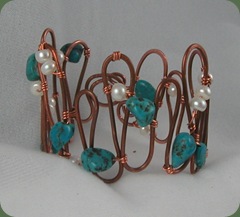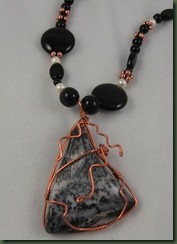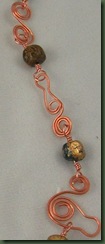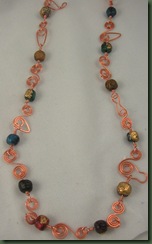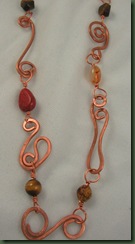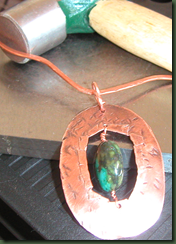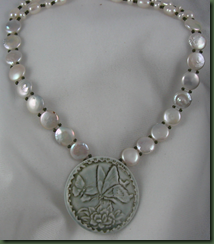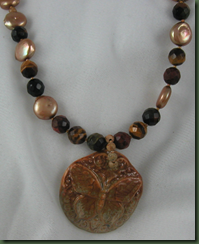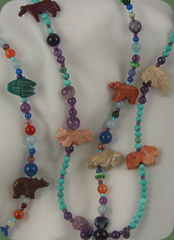I’m still “gone to the dogs” today.  Dovetails sent the dog in the picture home with me to use for a necklace. The dog is a pin and we thought it might be cute in another design. Sherry, from my wire work group, showed me how to create a wire coil with loops that will fit around the pin for attaching it. Thanks Sherry!
Dovetails sent the dog in the picture home with me to use for a necklace. The dog is a pin and we thought it might be cute in another design. Sherry, from my wire work group, showed me how to create a wire coil with loops that will fit around the pin for attaching it. Thanks Sherry!
After finishing the doggie necklace, complete with handmade copper wire dog bones, I donned it to be sure it would hang correctly. OOPS! That silly little dog wanted to flip over and lay on it’s stomach. Now What?
I had been to the Bead Jamboree in San Antonio and talked with a vendor selling plated charms, etc. She showed me how she glued filigrees on to the back of the charms that didn’t have holes in order to make a hanger. I more or less disregarded her suggestion thinking I would just drill a hole for the hangers I needed. But, when that puppy did its flip, I realized that her idea might be golden. 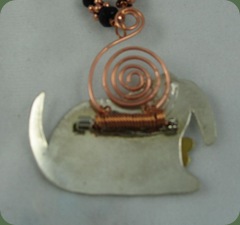 Using E 6000 glue, I attached the dog pin to the handmade filigree and “hurray” now he’s a dog on his feet.
Using E 6000 glue, I attached the dog pin to the handmade filigree and “hurray” now he’s a dog on his feet.
While I can’t proclaim that this is a major “aha” and some would say it was obvious all along, I do know that we must remain open to connections. Although I often disregard a technique someone it showing me, I do try to pay attention and store it in the back of my mind. You just never know when someone’s idea can be adapted to your own problem.
I guess that’s really what listening is all about – making connections for the now or for the future. Part of listening is honoring the person who is talking by giving him or her your attention. I’ve always thought it was my job to applaud the person for their discovery even if I didn’t value it for myself. Yet, someone else’s idea may later combine with your own adaptation when you least expect it.
Just think about the Wright Brothers who could fly their plane, but couldn’t make it turn. Watching an eagle tip its wings one day while making a turn is said to have provided them with the idea for making that first airplane turn. I’m sure glad they were paying attention or we all might be flying straight into mountains were it not for that great connection.
I’m looking forward to using this technique again on the bird pin that’s next on the queue. We’ll see what hatches.
By the way, you’ll soon find these necklaces at Dovetail of Wimberley just waiting to be adopted.

